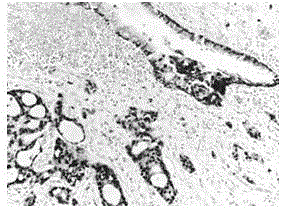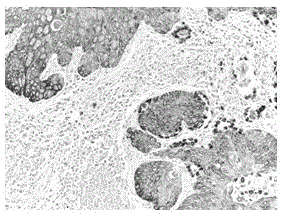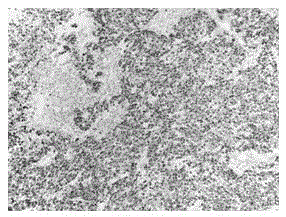Histological classification immunohistochemical multiple staining detection method for lung cancer
A detection method and immunohistochemical technology, applied in the field of lung cancer histological typing immunohistochemical multiple staining detection, can solve the problems of difficult typing, time-consuming and labor-intensive detection of immunohistochemical techniques separately, and achieve less staining steps and better experimental results Intuitive contrast, high stability effect
- Summary
- Abstract
- Description
- Claims
- Application Information
AI Technical Summary
Problems solved by technology
Method used
Image
Examples
Embodiment 1
[0027] The research object was formaldehyde-fixed-paraffin-embedded lung adenocarcinoma tissue (Department of Pathology, Fujian Provincial Hospital). The immunohistochemistry experiment procedure is as follows:
[0028] (1) Place the tissue slices in a 67°C incubator for 2 hours.
[0029] (2) Routine xylene dewaxing 3 times, 6 minutes each time, hydration in 100%, 100%, 95%, 85% gradient ethanol, 3 minutes each time, and finally rinse with tap water.
[0030] (3) Boil directly in pH9.0 EDTA antigen retrieval solution, cool to room temperature naturally, rinse with tap water and rinse with PBS for 3×3 minutes.
[0031] (4) Incubate in 3% hydrogen peroxide for 10 minutes at room temperature to block endogenous peroxidase, and rinse with PBS for 3×3 minutes.
[0032] (5) Block with normal animal serum for 10 minutes, discard the excess serum, without washing, add Napsin A, TTF-1, Desmoglein 3 mixed primary antibody dropwise, and the antibody titers in the mixed primary antibody are Napsin...
Embodiment 2
[0039] The object of study was formaldehyde-fixed-paraffin-embedded lung squamous cell carcinoma tissue (Department of Pathology, Fujian Provincial Hospital). The immunohistochemistry experiment procedure is as follows:
[0040] (1) Place the tissue slices in a 67°C incubator for 2 hours.
[0041] (2) Routine xylene dewaxing 3 times, 6 minutes each time, hydration in 100%, 100%, 95%, 85% gradient ethanol, 3 minutes each time, and finally rinse with tap water.
[0042] (3) Boil directly in pH9.0 EDTA antigen retrieval solution, cool to room temperature naturally, rinse with tap water and rinse with PBS for 3×3 minutes.
[0043] (4) Incubate in 3% hydrogen peroxide for 10 minutes at room temperature to block endogenous peroxidase, and rinse with PBS for 3×3 minutes.
[0044] (5) Block with normal animal serum for 10 minutes, discard the excess serum, without washing, add Napsin A, TTF-1, CK5 / 6 mixed primary antibody dropwise, and the antibody titers in the mixed primary antibody are Naps...
Embodiment 3
[0051] The object of study was formaldehyde-fixed-paraffin-embedded lung small cell carcinoma (Department of Pathology, Fujian Provincial Hospital). The immunohistochemistry experiment procedure is as follows:
[0052] (1) Place the tissue slices in a 67°C incubator for 2 hours.
[0053] (2) Routine xylene dewaxing 3 times, 6 minutes each time, hydration in 100%, 100%, 95%, 85% gradient ethanol, 3 minutes each time, and finally rinse with tap water.
[0054] (3) Boil directly in pH9.0 EDTA antigen retrieval solution, cool to room temperature naturally, rinse with tap water and rinse with PBS for 3×3 minutes.
[0055] (4) Incubate in 3% hydrogen peroxide for 10 minutes at room temperature to block endogenous peroxidase, and rinse with PBS for 3×3 minutes.
[0056] (5) Block with normal animal serum for 10 minutes, discard excess serum, without washing, add Napsin A, TTF-1, p40, TRIM29 mixed primary antibody dropwise, and the antibody titers in the mixed primary antibody are Napsin A 1:2...
PUM
| Property | Measurement | Unit |
|---|---|---|
| Thickness | aaaaa | aaaaa |
Abstract
Description
Claims
Application Information
 Login to View More
Login to View More - Generate Ideas
- Intellectual Property
- Life Sciences
- Materials
- Tech Scout
- Unparalleled Data Quality
- Higher Quality Content
- 60% Fewer Hallucinations
Browse by: Latest US Patents, China's latest patents, Technical Efficacy Thesaurus, Application Domain, Technology Topic, Popular Technical Reports.
© 2025 PatSnap. All rights reserved.Legal|Privacy policy|Modern Slavery Act Transparency Statement|Sitemap|About US| Contact US: help@patsnap.com



